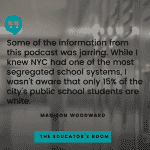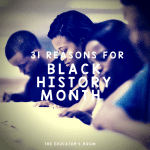The Educator’s Room Reviews WNYC’s “Keeping Score” Podcast
Have you signed up for The Educator’s Room Daily Newsletter? Click here and support independent journalism!
Keeping Score is a brand new 4-part series from WNYC Studios and The Bell. The series follows the real students of one Brooklyn high school building that houses four separate schools and recently integrated their athletic programs. Keeping Score hopes to unearth the structural inequalities of our school system by taking a closer look at this community as it undertakes a modern integration experiment. To read the review of part 1, click here.
Synopsis
Originally housing one school, the John Jay building wouldn’t stay homogenous for long. By the 2000s, the “small school movement” had taken hold in New York City. John Jay was split into three schools: Cyberarts Studio Academic, the Secondary School for Law, and Park Slope Collegiate. The stated intention at the time was to provide families with more options for schooling.
By 2004, Jill Bloomberg was one of the principals in the school and described the still rough conditions in the deteriorating building – water damage, leaking roof, toilets that didn’t flush, and rodents. Bloomberg made many requests for renovations and updates, but they were all ultimately denied. In 2010, however, the NY Department of Education wanted to add a fourth school: Millennium Brooklyn.
The DOE finally offered to renovate the building, but only if the other school administrators would agree to allow the new school to join the campus. Jill, who had long waited for improvements to be made, voiced her anger: “If the school is not good enough for the middle-class children who are overwhelmingly white, why is it good enough for the Black and Latino students who attend the school?” While other concerns were murmured and eventually voiced at a DOE town hall, the city’s education panel unanimously voted the new school into existence and began renovations.
Up to this point, the three existing schools all played under one sports team, the John Jay Jayhawks. But Millennium Brooklyn received a brand new team called the Millennium Phoenixes. Students and teachers quickly noticed inequities: Millennium students could usually afford exclusive club leagues and therefore had more experience and coaching than the Jayhawks. Additionally, despite the Jayhawks repeatedly having applications for additional sports teams denied, Millennium quickly had twice as many teams. This disparity gave credence to the long-held suspicions that the three original John Jay schools were willfully underresourced.
During the start of the pandemic, administrators at John Jay decided to integrate the teams and to play under the John Jay Jaguars once students returned from remote learning. Mariah (who we met in episode one) was initially excited about the teams integrating and trying out for the volleyball team. Once she showed up to tryouts, though, the reality started to sink in. Would integrating the teams create equity or breed more alienation?
Positives
There isn’t enough positive to say about this episode in the series. My previous review mentioned my desire to see more anecdotes and information about the segregation at John Jay and how it plagues the NYC public school system as a whole. Part 2 absolutely delivered, and, once again expertly weaves these details into the story of the John Jay Jaguars integration experiment. Though this episode is only about a half-hour in length, it packs an incredible amount of context and history into that time.
Room for Improvement
At this point, I think this podcast series is hitting the mark. I am eager to hear more about the rocky team integration, as well as hope to hear perspectives from the Millenium Brooklyn students.
Podcast Score
A+
Final Thoughts from an Educator
This episode of Keeping Score really resonated with me and reminded me of the inequity I have observed in numerous public school systems. While I cannot personally speak to the realities of New York City’s public schools, I have experienced wide disparities in my time as an educator in Arizona.
I interned and student taught at one district, including a stint at their brand new campus. That school was lauded for its amazing sports programs, extensive campus, and variety of course offerings. The first school I taught at was a newer building, but the fresh paint didn’t make up for the lack of resources for students and teachers. Lastly, the alternative school I worked at for multiple years had no permanent buildings, and despite many promises of a revamped campus, they never came to fruition.
The differences between these schools match with the socio-economic status and racial demographics of the attending students: the school I interned at was in an extremely affluent area, while my alternative school served students with behavioral challenges (and was largely low-income students of color). While it is easy to say these circumstances are unequal and suggest a different funding approach, the damage is not so quickly undone. I look forward to following the story of Keeping Score and learning how this community unravels the decades of inequity to integrate as one.
Editor’s Note: If you enjoyed this article, please become a Patreon supporter by clicking here.






